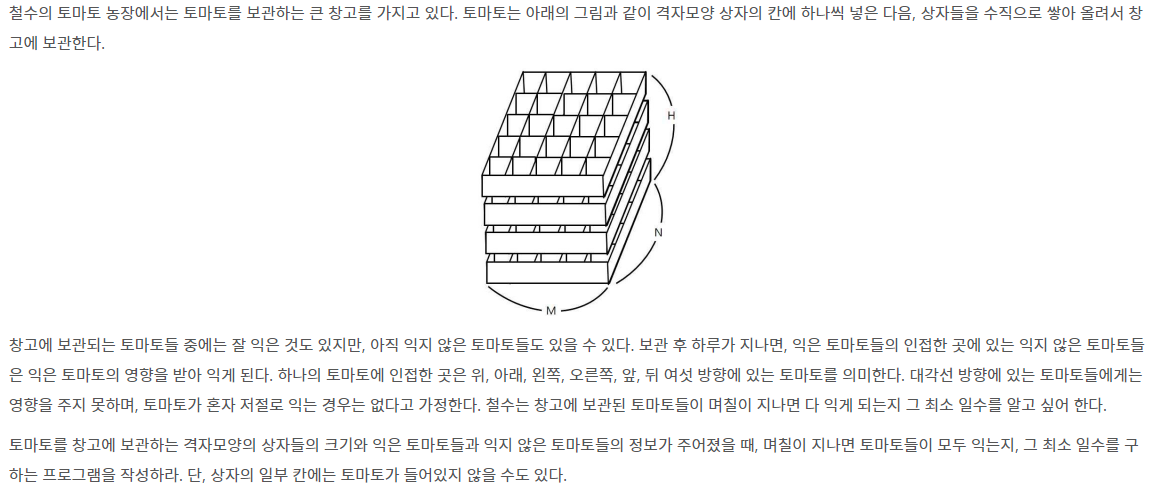📌 알고리즘 분류
해당 문제는 BFS에 대한 이해가 필요한 문제입니다.
BFS
📖 문제
기존의 토마토 문제에서 z축이 추가되었습니다. 알고리즘은 다르지 않습니다.
BFS(너비우선탐색)을 통해 최단거리를 구하고 해결합니다.
💻 코드
#include<iostream>
#include<algorithm>
#include<queue>
#include<tuple>
using namespace std;
int m, n, h;
int graph[101][101][101];
queue<tuple<int, int, int>> q;
int max_value = 1;
tuple<int, int, int> point;
//
int dx[6] = { -1 , 1, 0, 0,0,0 };
int dy[6] = { 0, 0 , -1, 1,0,0 };
int dz[6] = { 0, 0, 0, 0, -1, 1 };
void BFS()
{
while (!q.empty())
{
point = q.front();
q.pop();
for (int i = 0; i < 6; i++)
{
int next_z = get<0>(point) + dz[i];
int next_x = get<1>(point) + dx[i];
int next_y = get<2>(point) + dy[i];
if (0 <= next_x && next_x <= n && 0 <= next_y && next_y <= m && 0 <= next_z && next_z <= h)
{
if (graph[next_z][next_x][next_y] == 0)
{
q.push(make_tuple(next_z, next_x, next_y));
graph[next_z][next_x][next_y] += graph[get<0>(point)][get<1>(point)][get<2>(point)] + 1;
}
}
}
}
}
int main()
{
cin >> m >> n >> h;
int to;
int zero_count = 0;
for (int i = 0; i < 101; i++)
{
for (int j = 0; j < 101; j++)
{
for (int k = 0; k < 101; k++)
{
graph[i][j][k] = -2;
}
}
}
for (int i = 0; i < h; i++)
{
for (int j = 0; j < n; j++)
{
for (int k = 0; k < m; k++)
{
cin >> to;
graph[i][j][k] = to;
if (to == 1)
{
q.push(make_tuple(i, j, k));
}
if (to == 0)
zero_count++;
}
}
}
if (zero_count == 0)
{
cout << "0\n";
return 0;
}
BFS();
for (int i = 0; i < h; i++)
{
for (int j = 0; j < n; j++)
{
for (int k = 0; k < m; k++)
{
if (graph[i][j][k] == 0)
{
cout << -1 << "\n";
return 0;
}
}
}
}
for (int i = 0; i < h; i++)
{
for (int j = 0; j < n; j++)
{
for (int k = 0; k < m; k++)
{
max_value = max(max_value, graph[i][j][k]);
}
}
}
cout << max_value - 1 << "\n";
}


